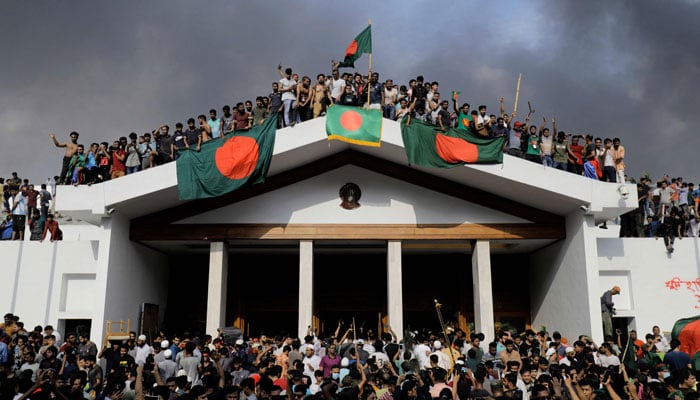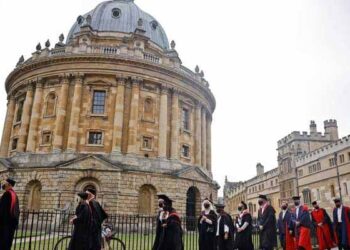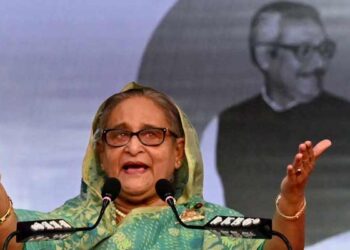Select Language:
Anti-government protesters wave Bangladesh’s national flag as they storm Prime Minister Sheikh Hasina’s residence in Dhaka on August 5, 2024. — AFP
- Student-led protests resulted in the overthrow of Hasina’s government on August 5, 2024.
- The former prime minister fled to India after protesters seized control of the Dhaka palace.
- Sheikh Hasina, aged 77, has refused to comply with court orders to attend her ongoing trial.
Dhaka: The once heavily guarded residence of Bangladesh’s ousted Prime Minister Sheikh Hasina is being transformed into a museum, serving as a lasting reminder of her authoritarian tenure.
Images capturing crowds celebrating with flags atop the Dhaka palace following Hasina’s helicopter escape to India marked the height of student-led protests that toppled her administration on August 5, 2024.
A year later, amidst ongoing political chaos in Bangladesh’s population of approximately 170 million, officials hope that the expansive Ganabhaban palace will serve as a message to future generations.
Graffiti condemning her regime remains untouched on the walls, with messages such as “Freedom” and “We want justice” still visible.
Hasina’s leadership was characterized by widespread human rights violations, including mass detentions and extrajudicial killings of political opponents. The United Nations estimates that up to 1,400 individuals were killed during July and August 2024 as she desperately clung to power.
Despite being summoned, Sheikh Hasina continues to defy court orders to appear at her trial on charges related to crimes against humanity, which she denies.
Another slogan—“Killer Hasina”—appears among the remnants of her legacy, protected for posterity.
Muhammad Yunus, 85, the Nobel Peace Prize laureate leading the caretaker government until the 2026 elections, stated that converting the palace into a museum would “preserve memories of her misrule and the people’s anger as they removed her from power.”
A symbol of trauma and suffering
Mosfiqur Rahman Johan, 27, a rights activist and documentary photographer, was among the thousands who stormed the opulent palace, recounting how crowds danced in her private chambers, feasted from the palace kitchens, and swam in the lake she once used for fishing.
“It will visualize and symbolize the past trauma, the pain and the resistance,” he said.
“Ganabhaban is a symbol of fascism, representing an autocratic regime.”
Constructed by Sheikh Hasina’s father, Sheikh Mujibur Rahman—the founding leader of Bangladesh—the palace served as her official residence during her 15-year rule.
Tanzim Wahab, the museum’s curator-in-progress, told AFP that exhibits would include artifacts of those killed during protests. Personal stories will be shared through photographs and films, while plaques will list the names of individuals slain by security forces during her lengthy regime.
“The museum’s deeper purpose is to reflect on years of misrule and oppression,” Wahab explained. “That’s one of the most critical aspects of this project.”
The museum will feature interactive displays, animations, and documentation of the cramped detention cells where her opponents were held in inhumane conditions.
“We want young people to engage with this as a platform to discuss democracy, fresh ideas, and how to build a new Bangladesh,” Wahab added.
A symbol of dictatorship
This initiative aligns with interim leader Muhammad Yunus’s efforts to strengthen democratic institutions before the elections—although progress has been slow amid political infighting, according to Human Rights Watch, which issued a warning ahead of the revolution’s anniversary.
“The interim government seems stuck, managing an unreformed security sector, sometimes-violent religious hardliners, and political factions more interested in revenge than protecting citizens’ rights,” HRW said.
While the palace is preserved as a historical site, many other symbols of Hasina’s rule have been dismantled. Statues honoring her father have been toppled, and portraits of Sheikh Mujibur Rahman were shredded or set ablaze.
Protesters even used excavators to demolish the house of Sheikh Mujibur Rahman—turned into a museum by Hasina—symbolizing a rejection of her legacy.
“When dictatorship falls, its remains must go too,” said Muhibullah Al Mashnun, a 23-year-old student involved in tearing down the house.
He believes removing these symbols is essential for Bangladesh’s progress toward a better future, calling them “statues of dictatorship.”







